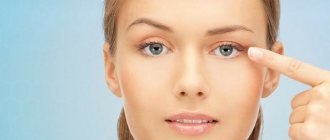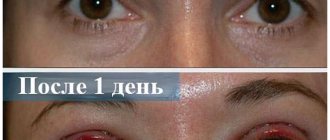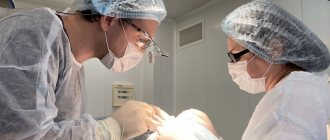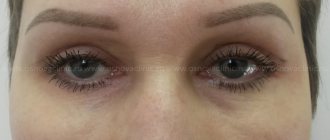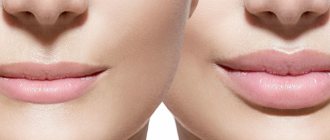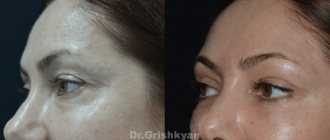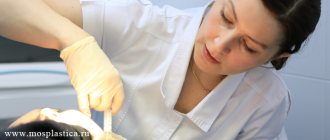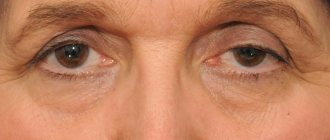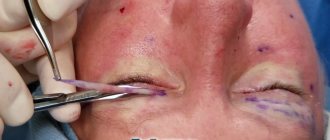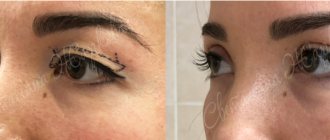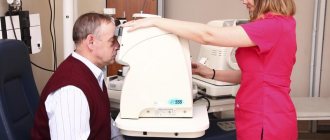So, we have learned everything about rehabilitation after different types of blepharoplasty. We talked in detail about how recovery occurs day by day.
Today I want to summarize everything that I told you. And write down point by point: what cannot be done after blepharoplasty, and what can be done.
Naturally, I will not talk about simple truths. I think you yourself know that you should not rub your eyes, feel your stitches, play sports or use cosmetics. And you even know why.
I will explain the remaining prohibitions, which often raise a lot of questions among patients.
Medications
In almost every article about preparing for surgery or rehabilitation, I talk about how important it is to tell your doctor about all the medications you are taking.
Why?
Some medications may affect the outcome of surgery. Some may cause the procedure to be prohibited. This is especially true for drugs that affect the blood.
Why is it important to remember this after blepharoplasty?
The plastic surgeon will prescribe the necessary medications for you. Painkillers, at a minimum, if necessary.
He will also inform you about when it will be possible to return to the medications that you took before preparing for the procedure.
But the most important thing: if after the rehabilitation period you feel unwell, caught a cold, or received severe bruises, the surgeon will coordinate the use of appropriate medications. It is very important. Because there remains a risk of complications, including those associated with medications.
Dry eyes after eyelid surgery
Table of contents
What is blepharoplasty?
Why is eyelid surgery necessary? Why does dry eye syndrome (DES) develop after eyelid surgery? How does dry eye syndrome manifest after surgery? How to treat dry eye syndrome? Preparing for surgery Caring for yourself after surgery What symptoms should you see a doctor for? Gilan solution to eliminate dry eyes What is blepharoplasty?
Blepharoplasty is an operation to eliminate congenital or acquired eyelid defects. It allows you to get rid of edema, fatty hernias, drooping eyelids that appear due to age-related changes or diseases of the cardiovascular system and kidneys.
Why is eyelid surgery necessary?
In most cases, blepharoplasty is performed for cosmetic purposes, but sometimes it is necessary to restore full peripheral vision.
Upper eyelid blepharoplasty is aimed at removing excess fat, skin and muscle. It is performed through an incision in the upper eyelid. Due to the natural folding of the skin in this area, the incision site is almost invisible after healing.
Blepharoplasty of the lower eyelid can be performed using both surgical and non-surgical methods. Surgery is used to remove fatty hernias. They are removed through small incisions on the outside of the lower eyelids. Scars may remain at the site of surgical wounds.
For patients without significant sagging skin, transconjunctival blepharoplasty is indicated, which is considered more gentle, since the incision is made on the inside of the eyelids and heals almost without a trace.
Why does dry eye syndrome (DES) develop after eyelid surgery?
Unpleasant sensations and dry eyes are a proven side effect of blepharoplasty. It is experienced by about 50% of patients undergoing surgery. In approximately half of them, dry eye syndrome develops immediately or some time after eyelid correction, and 26% of patients experience swelling of the conjunctiva.
Consequences such as dry eyes occur due to disruption of the integrity of the optic nerves. As a result, the mechanism for producing tear fluid malfunctions, the cornea does not wet itself in time and becomes covered with microcracks. During the postoperative rehabilitation period, the risk of infectious inflammation of the cornea increases sharply.
How does dry eye syndrome manifest after surgery?
The clinical picture of dry eye disease varies depending on the stage of the disease.
- At the initial stage, blepharoconjunctivitis develops, which is accompanied by pain and the sensation of a foreign body in the eyes, redness of the edges of the eyelids, and the appearance of mucous discharge.
- At the next stage, epithelial dystrophy of the cornea is observed. Dryness of the eyes intensifies, photophobia appears, and threads with a freely hanging end are formed on the surface of the cornea.
- At the third stage, filamentous keratitis develops. This condition is characterized by the formation of a mesh of threads filled with mucus on the eyeball. The patient's vision deteriorates sharply, pain and pain in the eyes intensify.
- In the last stage, corneal xerosis occurs. Due to insufficient tear fluid, the nutrition of the cornea and conjunctiva is disrupted. Blood vessels grow on the surface of the cornea, which leads to vision loss.
How to treat dry eye syndrome?
The treatment program in most cases is based on the use of tear substitutes. These drugs have a stabilizing effect and moisturize the surface of the eyes. Depending on the severity of symptoms, the viscosity of the artificial tear preparation is selected. Additionally, anti-inflammatory and antibacterial drugs are prescribed to reduce postoperative inflammation.
Preparing for surgery
Before blepharoplasty, a number of laboratory tests must be done. It is advisable to get tested for dry eye syndrome, since if the disease is present, the likelihood of severe complications increases.
Self-care after surgery
Blepharoplasty, like any other operation, leaves the body defenseless against infections for a certain period. In the first few days, you must maintain careful hygiene: do not use cosmetics, do not wash your face with running water, and do not touch your eyes with your hands.
The recovery period takes about 14 days. To prevent dry eye syndrome and other complications, a tear substitute prescribed by an ophthalmologist is used. To reduce swelling, topical medications may be prescribed.
During the postoperative period, it is extremely important to follow all the doctor’s recommendations and not self-medicate if complications arise.
What symptoms should you see a doctor for?
Blepharoplasty is a technically simple operation, so the occurrence of complications is most often associated with the individual characteristics of the body or failure to comply with rehabilitation requirements.
Swelling of the eyelids and hematomas usually disappear within 1-2 weeks. If this does not happen, or after the swelling has subsided, increased lacrimation, redness of the suture, increased body temperature, and increased pain around the incision site are observed, immediately consult a doctor.
Due to severe swelling and infectious inflammation, sutures may come apart.
Gilan solution to eliminate dry eyes
Tear substitute "Gilan" has a moisturizing effect for dry eye syndrome after blepharoplasty. An ophthalmic solution based on hyaluronic acid prevents the development of complications, alleviates painful conditions, and promotes the rapid elimination of edema.
Sun, solarium and sauna
During the rehabilitation period you cannot:
- Be in direct sunlight.
- Sunbathe in the solarium.
- Visit baths and saunas.
- Swim in the pools.
Ultraviolet radiation is a necessary and inevitable part of life. Thanks to ultraviolet radiation, vitamin D is synthesized, other chemical reactions occur in the body, immunity increases, and mood improves. But it is no longer news that ultraviolet radiation can cause harm to living tissues. Therefore, a number of postoperative restrictions are associated with it.
Any plastic surgeon will recommend that you not only refrain from visiting beaches and solariums, but also wear sunglasses constantly for six months.
Why are baths and saunas dangerous?
When visiting such places, there is a risk of catching an infection or simply catching a cold (this also applies to swimming pools).
And, more importantly, when visiting such places, the body heats up. Blood vessels dilate. This contributes to increased swelling. And it can provoke a deterioration in the patient’s well-being.
Rehabilitation after lower eyelid surgery by day
The rehabilitation period can be divided into two periods: the early period and the late period.
Early rehabilitation lasts approximately half a month.
For the first three days of the recovery period, you will have to wear a special plaster, which the surgeon glues to the stitches.
During these days, most patients experience discomfort due to severe swelling and bruising under the eyes.
To prevent swelling from becoming too great, cold compresses should be applied to the eyes for the first hours after the procedure.
When the patch is removed, the doctor treats the stitches with special antiseptic preparations. This is done so that the wound heals faster and does not get infected.
At this point, the doctor prescribes eye drops and special ointments that should be used to regularly treat the eyes. When the suture is completely healed, you are allowed to do eye exercises and light massage at the incision site.
Since our clinic uses self-absorbing threads, there is no need to remove sutures.
During the first week, patients often experience tolerable pain. To reduce pain, the doctor prescribes painkillers.
Swelling goes away already on the 9-10th day, and bruises completely disappear after 2 - 3 weeks.
Limitations in the early period of rehabilitation
During the first two weeks after surgery, a person must do everything to prevent swelling from increasing. This means that you need:
- Sleep with your head slightly elevated on your back
- Apply cold compresses
- Avoid eating very salty, spicy, sour and fatty foods
- Do not drink alcohol (especially carbonated drinks)
- No smoking
- To prevent your eyes from becoming overtired, you should stop watching TV, reading books, or working on the computer for a while.
- When washing, you should use mild soap and it is important to do this very gently. During the first week, you should never touch your eyelids. You need to wipe your face very carefully, simply soaking the towel.
- Under no circumstances should you bend over or be exposed to heavy physical exertion. This can lead to serious complications.
- You can wash your head by tilting it back (maybe ask someone from your family to help)
- You cannot take a hot shower, go to the bathhouse or visit the sauna.
- Don't drink too much or too little liquid. It is better to give up coffee during this period.
In order to prevent infection of incisions, you must adhere to the following rules:
- During the first days, you should not touch the seams with your hands often.
- Don't get the wound wet
- You can't swim in the pool
- Sutures must be regularly treated with antiseptics, which will be prescribed by the doctor.
- For the first 14 days you should not apply makeup to your face.
- You can use herbal infusions to wash your face
To ensure that the procedure does not affect vision, it is important:
- Moisturize your eyes with special drops
- Wear sunglasses
- Avoid contact lenses
Late rehabilitation period
After three weeks it will be possible to return to the normal rhythm of life. At this time, you need to continue to massage the sutures so that noticeable scars do not form.
Complete healing occurs within one and a half to two months. In difficult cases, rehabilitation may take longer.
When do sutures heal after upper eyelid surgery?
The stitches are tightened after ten days. When they have healed well (on the fifteenth day), you can and even need to do a special eyelid massage and eye gymnastics. As a result, after two months the scar will be practically invisible. In some cases it takes longer.
The speed of healing of sutures depends not only on the skill of the surgeon and the extent of the surgical intervention, but also on the patient himself. In older people, healing is slower than in younger patients. If you do not take the rules of conduct during rehabilitation seriously, there is a possibility that the sutures will become inflamed and this will slow down the recovery process.
What care is needed during the recovery period?
If you take proper care of your eyes, you can avoid many unwanted complications. This care includes:
- Gymnast for the eyes
- Eyelid massage
- Physiotherapeutic procedures
- The use of ointments that help improve blood circulation and skin regeneration. The stitches need to be coated with ointment, which was prescribed by the surgeon.
On plastic surgery forums, patients share that they used hydrocartisone ointment. And to reduce bruises they used Sinyakoff ointment.
Don't strain your eyes
Another group of prohibitions concerns gadgets, TV and even books.
Once during a consultation I was asked: “What, after blepharoplasty I shouldn’t look at my phone, play on a tablet or even watch TV for a month?!”
Of course not! We are talking about the need to reduce contact with technology and books, and not about a complete ban.
Firstly, our age involves close contact with gadgets. There is no escape from it.
Secondly, there is no point in a complete ban. We are not restoring vision, but removing imperfections of a different kind.
You just need to use smartphones minimally. Don’t scroll through the news feed for an hour, don’t watch TV series, don’t read e-books.
Your eyes need rest.
Bad habits
Alcoholic drinks and cigarettes are two problems that, unfortunately, are familiar to a very large number of my patients.
No matter how long I talk about their harmful effects on the body. No matter how much you talk about the risks. All the same, heavy smokers relapse. And many believe that “two sips will do nothing at the holiday.”
Once again I urge you to be patient. Rehabilitation after blepharoplasty does not last a year, or even six months.
Avoid cigarettes and alcohol for at least a month. And enjoy your rejuvenated, refreshed eyes!
Here you can make an appointment with me for a consultation. I will be happy to answer your questions!

